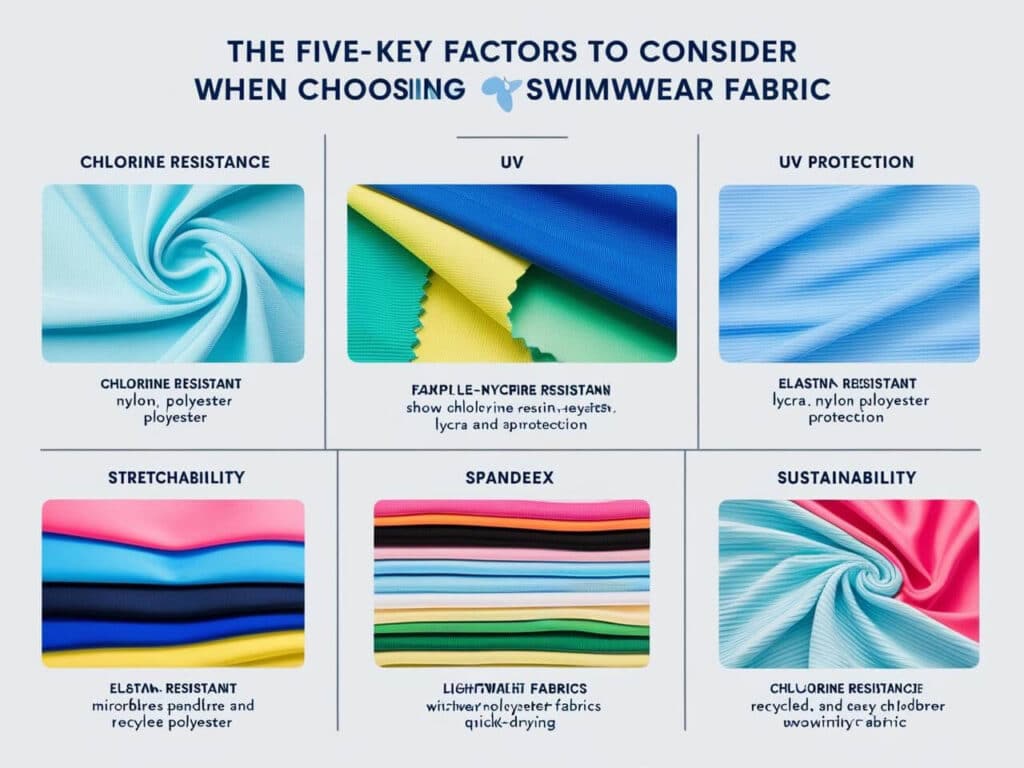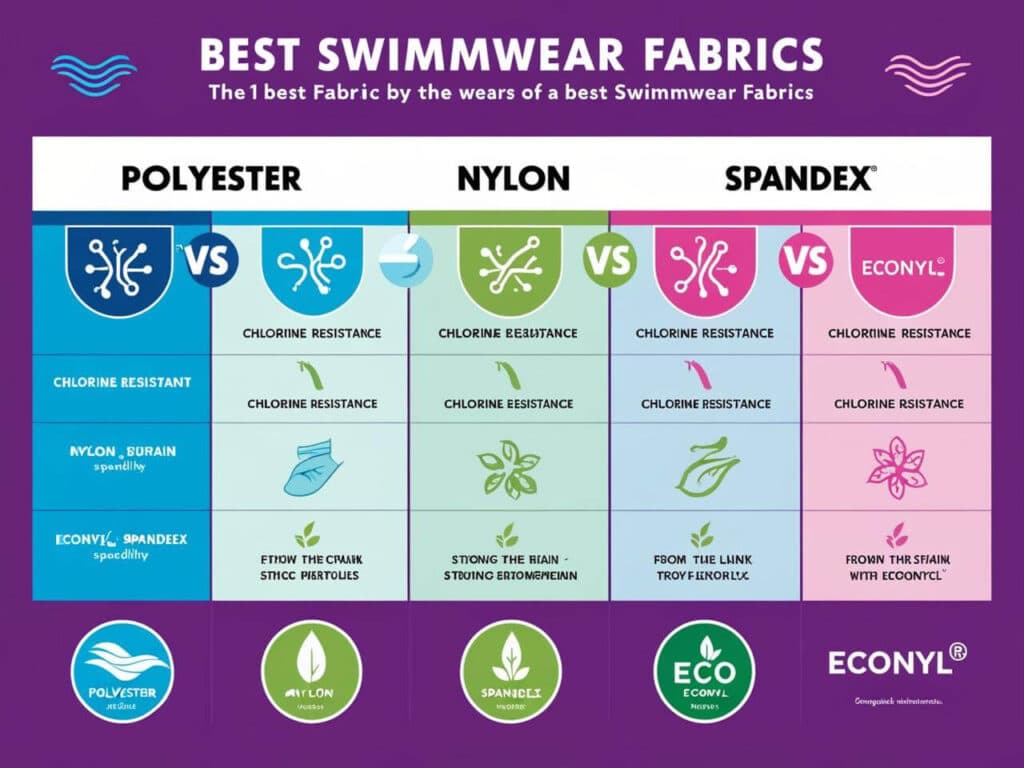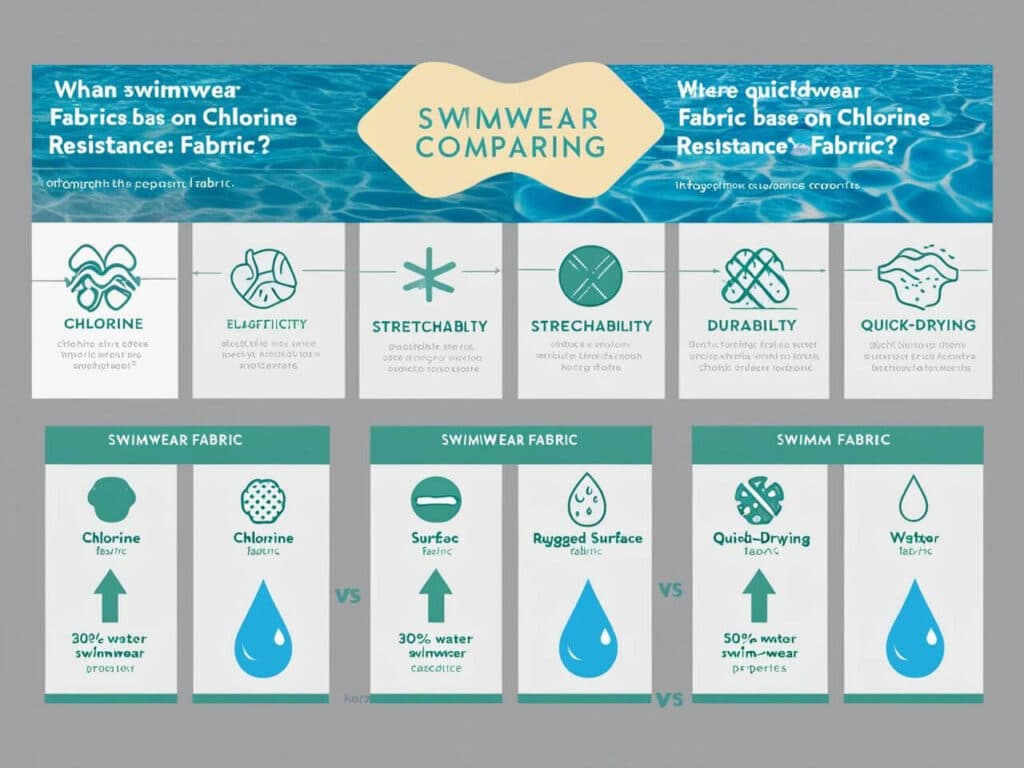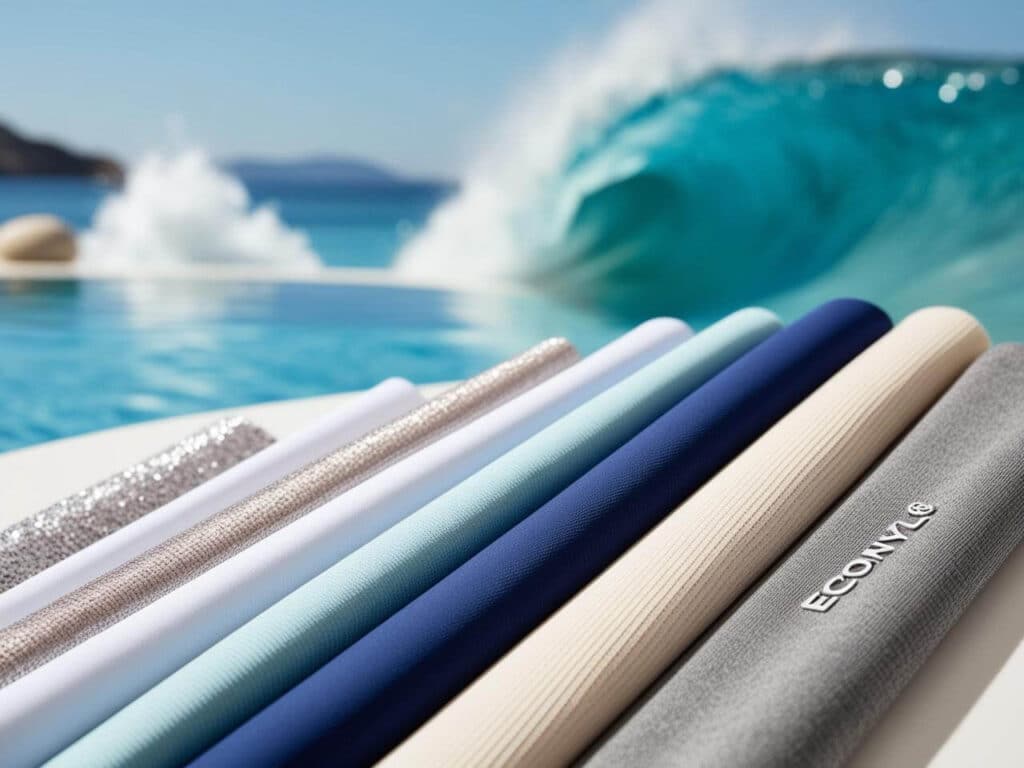Introduction
Choosing the right fabric for swimwear is more important than you might think. A good swimsuit should be comfortable, durable, and resistant to water and sun exposure. The wrong fabric can lead to stretching, fading, or slow drying, making your swimwear uncomfortable and short-lived.
I’ve spent time researching and testing different swimwear fabrics to find out which materials work best for various swim activities—from casual beachwear to high-performance swimwear.
In this guide, you’ll learn:
- The best swimwear fabrics and their advantages.
- Which materials last the longest in chlorine and saltwater.
- Eco-friendly options like ECONYL® for sustainable swimwear.
Whether you’re buying a new swimsuit or designing your own, let’s find the perfect fabric for your needs.
Key Factors to Consider When Choosing Swimwear Fabric

When selecting swimwear fabric, it’s essential to focus on durability, flexibility, and resistance to water conditions. Here are the key factors to consider:
1️⃣ Chlorine & Saltwater Resistance 🌊
✔ Why it matters: Chlorine in pools and salt in the ocean can break down fabrics, causing fading, stretching, and thinning.
✔ Best fabrics: Polyester and ECONYL® are highly resistant to chlorine and salt.
✔ Worst fabrics: Pure spandex (Lycra) degrades quickly in pools without a protective blend.
2️⃣ UV Protection & Color Retention ☀️
✔ Why it matters: Sun exposure weakens some fabrics over time, leading to fading and reduced durability.
✔ Best fabrics: Polyester and nylon with UV-blocking treatments provide longer-lasting color and fabric strength.
✔ Worst fabrics: Non-treated nylon blends may lose elasticity under prolonged sun exposure.
3️⃣ Stretch & Flexibility 🤸♀️
✔ Why it matters: Swimwear should allow for free movement, whether you’re swimming, surfing, or lounging.
✔ Best fabrics: Spandex (Lycra/Elastane) blended with polyester or nylon for a 4-way stretch effect.
✔ Worst fabrics: 100% polyester lacks flexibility unless blended with spandex.
4️⃣ Quick-Drying Ability ⏳
✔ Why it matters: A quick-drying swimsuit reduces water absorption, making it more comfortable and lightweight after swimming.
✔ Best fabrics: Polyester and nylon dry faster than natural fibers.
✔ Worst fabrics: Cotton or heavy fabric blends stay wet for too long, making them uncomfortable.
5️⃣ Sustainability & Eco-Friendly Choices 🌿
✔ Why it matters: More brands are turning to recycled materials to reduce ocean waste and plastic pollution.
✔ Best fabrics: ECONYL® (recycled nylon) and Repreve® (recycled polyester) are leading sustainable choices.
✔ Worst fabrics: Traditional polyester and nylon require petroleum-based production, impacting the environment.
Best Fabrics for Swimwear (Pros & Cons)

Different fabrics perform differently in water. Here’s a breakdown of the best materials for swimwear, their advantages, and potential downsides.
1️⃣ Polyester – The Most Durable & Chlorine-Resistant
✔ Highly resistant to chlorine and UV exposure – lasts longer in pools.
✔ Quick-drying – retains shape after multiple washes.
✔ Excellent color retention – prevents fading over time.
🔻 Less stretchy than nylon or spandex.
📌 Best for: Competitive swimwear, lap training, long-term use.
2️⃣ Nylon – Soft, Lightweight & Stretchy
✔ Super lightweight & comfortable against the skin.
✔ More flexible than polyester – often used in fashion swimwear.
✔ Fast-drying – ideal for water sports and recreational use.
🔻 Less chlorine-resistant – can degrade faster in pools.
📌 Best for: Bikinis, one-piece swimsuits, and active swimwear.
3️⃣ Spandex (Lycra/Elastane) – Maximum Flexibility
✔ 4-way stretch for unrestricted movement.
✔ Blended with polyester or nylon for better durability.
✔ Enhances body-hugging fit & shape retention.
🔻 Not chlorine-resistant – can wear out faster without a protective blend.
📌 Best for: Performance swimwear, competitive racing suits.
4️⃣ ECONYL® – The Sustainable Swimwear Fabric
✔ Made from recycled ocean plastics & fishing nets.
✔ Performs like virgin nylon with added sustainability benefits.
✔ Strong, flexible, and UV-resistant.
🔻 More expensive than traditional fabrics.
📌 Best for: Eco-friendly swimwear, sustainable bikinis.
🔗 External Resource:
Swimwear Fabric Comparison Table

To help you compare different swimwear fabrics, here’s a detailed side-by-side breakdown of their key properties.
| Fabric | Chlorine Resistance | Stretchability | Durability | Quick-Drying | Best For |
| Polyester | ✅ High | ⚠️ Medium | ✅✅ Excellent | ✅ High | Competitive swimming, training suits |
| Nylon | ⚠️ Medium | ✅✅ Excellent | ✅ High | ✅✅ Fast | Bikinis, casual swimwear |
| Spandex | ❌ Low | ✅✅ Maximum | ⚠️ Medium | ✅ High | Flexible swimwear, racing suits |
| ECONYL® | ✅ High | ✅ High | ✅ High | ✅ High | Sustainable swimwear, eco-friendly brands |
🔗 External Resource:
FAQs (People Also Ask)
Here are answers to some of the most frequently asked questions about swimwear fabrics based on Google’s “People Also Ask” section.
❓ What is the best fabric for swimsuits?
✔ Polyester and nylon are the most popular choices due to their durability, water resistance, and stretchability.
❓ Which swimwear fabric lasts the longest?
✔ Polyester is the most chlorine-resistant fabric, making it ideal for competitive swimwear and frequent swimming.
❓ Is spandex good for swimwear?
✔ Yes, but it must be blended with polyester or nylon to improve durability and prevent rapid wear in chlorinated pools.
❓ What is the best eco-friendly fabric for swimwear?
✔ ECONYL® is the top choice—it’s made from recycled ocean plastics and discarded fishing nets while offering the same performance as nylon.
❓ Do swimsuits dry fast?
✔ Polyester and nylon dry the fastest, while fabrics with higher spandex content retain more water and take longer to dry.
Choosing the Best Fabric for Your Swimwear
Selecting the right swimwear fabric is key to comfort, performance, and durability. Whether you’re lounging on the beach or training in the pool, your choice of material can impact stretch, drying time, and longevity.
✔ Key Takeaways:
- Polyester – Best for competitive swimming, highly chlorine-resistant.
- Nylon – Soft, stretchy, and quick-drying, perfect for fashion swimwear.
- Spandex – Offers maximum flexibility, ideal for performance swimsuits.
- ECONYL® – A sustainable choice, made from recycled materials while maintaining durability.
✔ Final Tips:
- If you swim frequently in pools, choose polyester-based swimwear.
- If you want stretch & comfort, go for nylon with spandex blends.
- If you prefer eco-friendly options, look for brands using ECONYL®.
Final Thoughts
By understanding the pros and cons of each swimwear fabric, you can make a smarter choice that balances comfort, durability, and sustainability. No matter your preference, investing in high-quality swimwear materials ensures long-lasting performance in the water.
